Summary
Probably not, although direct evidence is lacking. Indeed, despite a large fox killed in Kent during 2010 sparking fears that urban foxes, fed on ‘a mountain of scraps and bin waste’, were getting bigger and ‘more vicious’, the real story may be quite the opposite. Many factors interact to control the size to which an animal grows; although they’re predominantly under genetic control, they can be significantly influenced by external factors, such as food availability and climate. It is certainly plausible that foxes with a plentiful supply of high-quality food could evolve larger body size, but there is no empirical evidence that they have done so yet in response to rich pickings in our metropolises. One recent analysis of skulls from London suggests some aspects are actually reducing in size.
The Details
The capture, in December 2010, of a large fox in a suburb of Kent prompted comments in the media about how urban foxes are growing larger; one headline read “Foxes are getting bigger… and more deadly”. This article, written for the Daily Mail by a London-based pest controller and published in January 2011, made disturbing reading; statements were made about how foxes the size of the Kent specimen are becoming far more common since fox numbers have apparently exploded “as a direct result” of local councils rounding up stray dogs.
The Kent specimen was a dog fox weighing 12 kg (26.5 lbs) and measuring 123 cm (4 ft) nose-to-tail. The author of the Daily Mail article noted that, three months earlier, he had shot a 2 stone 3 lb (14 kg) animal in South London and the largest he had seen during his 36 year career was 2 st 7 lb (just under 16 kg). Unfortunately, the article made many claims that are either entirely inaccurate or for which there is simply no evidence. It was, nonetheless, part of a larger ‘ground swell’ of public concern—since the disturbing case of the Koupparis twins in June 2010—that urban foxes now pose a significant risk to people and their pets. The debate was reignited in March 2012 when an even larger fox, weighing just over 17kg/38 lbs and measuring 145 cm/4ft 9in, was shot on a farm in Aberdeenshire. So, are such fears founded and what is it that controls how big a fox grows?
Little or large?
Exactly what controls body size in mammals is a complicated question that biologists are only now starting to understand. Data from several species, including mice and humans, have shown that proteins and short chains of amino acids called peptides control the behaviour of cells growing in developing tissues – these molecules are collectively called growth factors. Many growth factors are hormones and the pituitary gland that sits under the brain is instructed to release them by the hypothalamus. Hormones are essentially chemical messengers that tell the tissues to put all their resources into making a certain protein; proteins being the building blocks of your body. One hormone in particular, Somatotropin (known more colloquially as “Growth Hormone”), plays a major part.

Somatotropin is produced, stored and secreted by special cells called somatotropes in the front section of the pituitary gland (the adenohypophysis). Somatotropin stimulates protein production on a body-wide scale and, when released into the bloodstream, it takes one of two main pathways: it either acts directly on the body to increase muscle mass, strengthen bones, promote organ growth etc., or it acts on the liver, causing the production of hormones called insulin-like growth factors (IGFs), which promote bone growth. Overproduction or shortages of somatotropin can have profound effects on body size; extreme cases being gigantism and dwarfism, respectively. Much depends, however, on when during the growth phase the hormones are altered; new-born mammals are largely insensitive to them, while puberty appears a particularly important period.
So, somatotropin is an important hormone (one of several) when it comes to building a body and how much of it is flowing around an animal’s system is influenced by the environment, genetic make-up and nutrition. Building tissue is an energy-hungry process, so it makes sense that the amount of food available can ultimately influence final body size and we see this in many species; malnourished individuals end up smaller than their well-fed counterparts. We also know that aberrations in the pituitary that impact hormone secretion (cancers, for example) can lead to developmental changes in the animal. The question, however, is why we don’t see much larger variations in size if nutrition is so important? The answer lies in the animal’s genetic blueprint, behaviour and physiology.
In 1945, experiments on two different genetic ‘types’ of salamanders (differing in the number of paired chromosome sets) found they both grew to the same size, but had different overall numbers of cells. Basically, the size of a given object is dependent on two factors: the size of the building blocks and the number of building blocks. In this example, the cells of ‘polyploid’ salamanders are twice the size of those of ‘diploid’ salamanders and yet the two animals grow to the same size; the reason is that polyploid salamanders had half the number of cells of the diploid ones. Observations such as these led scientists to speculate that developing tissues ‘know’ how big they should grow. Several subsequent experiments have yielded similar results, with transplanted body organs growing to their normal size, even though they did so ‘out of context’.
The other aspect of growing larger is maintaining proportions, so that you don’t end up with, for example, really big hands but a small head. In October 1980, two German geneticists published a paper in the journal Nature in which they described 15 genes that were of fundamental importance in regulating the structure of a developing fruit-fly. These genes, which we now call Hox genes, set out the basic structure and segmentation of an organism, controlling what tissues develop into the head, the chest, the midriff, etc. Hox genes build ‘hox proteins’ that activate or deactivate other genes responsible for building the body. If you fiddle with the genes, you can change the structure of an organism; you can cause a fly’s antennae to develop into a leg, for example.
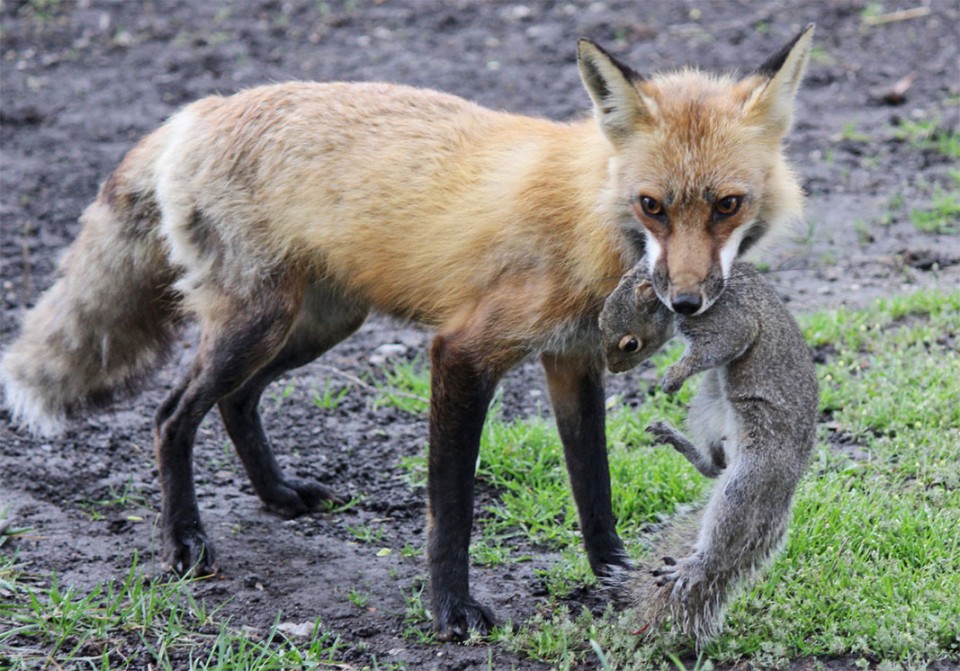
Since 1980, more genes that regulate growth have been discovered. A gene called c-Myc, for example, was recently found to regulate body size in mice by controlling the number of cells in a developing tissue; when the geneticists reduced the amount of c-Myc protein produced, the mice were much smaller than normal. The gene IGF-1 was also recently identified as a significant factor responsible for the great variation we see in dog breeds – a mutation of this one gene is largely responsible for the vast difference in size between the Chihuahua and the Great Dane. When you look at the tissues of the c-Myc mice and different dog breeds it becomes apparent that, in mammals at least, variation in body size is almost exclusively a result of variations in the number of cells and not the size of those cells.
In a very interesting paper to the journal BioEssays during 2008, Michael Crickmore at New York’s Rockefeller University and Richard Mann at Columbia University’s Medical Center described how starvation in (or general disruption of) the signalling of the hormone insulin results in the development of smaller animals with smaller, although still properly proportioned, organs. Insulin and somatotropin fluctuate in relation to the amount of sugar in the blood. Crickmore and Mann suggest that nutrient signals such as blood glucose provides information to tissues about the overall size of the animal in which it’s growing, while selector genes (such as Hox and c-Myc) provide organ-specific information. In other words, the available food controls the overall size of the animal, while these selector genes control the relative size of the various limbs and organs. There are several examples of how these ‘nutritional signals’ play a key role in the body size of wild mammals.
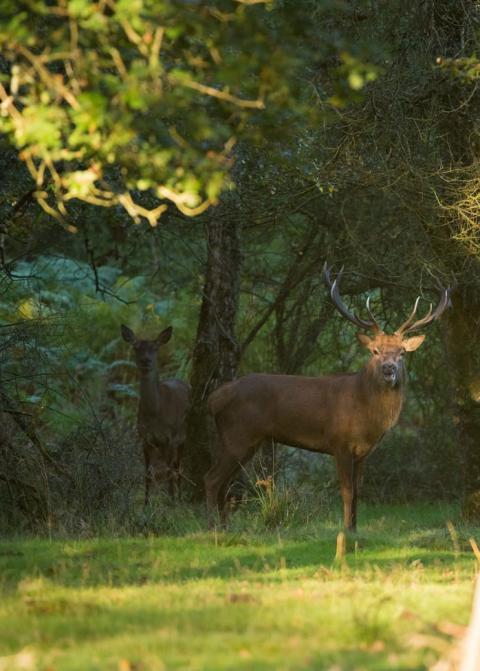
The North Atlantic Oscillation and Sub-Polar Gyre (two large circulations in the Atlantic Ocean) can affect continental weather and, as a result, the food available to animals living on those continents. Changes in these circulations over time have been linked to changes in Arctic fox (Vulpes lagopus) body size. Similarly, when red deer (Cervus elaphus) were introduced to New Zealand, the abundance of food led to an increase in body size over their British ancestors; they returned to their normal size when food conditions deteriorated. In a fascinating paper to the journal Biological Reviews published in 2011, Israeli biologists Yoram Yom-Tov and Eli Geffen discussed some of the recent changes in body size that have been documented in land animals.
In their paper, Yom-Tov and Geffen presented a flowchart containing 15 interrelated factors that affect the final body size of an animal; these included celestial factors (movements of the Earth and Sun affect plant growth and weather patterns), air pressure, temperature (big animals suffer in hot conditions, while small ones suffer in the cold), precipitation, human influences (management, garbage etc.) and the availability of food. They note that the quantity and quality of nutrition during growth is a key predictor of body size and the effects of this nutrition on skeletal growth carry over into adulthood.
So, if the overall body size is controlled by nutrition, why aren’t all well-fed foxes giants? Well, part of the reason, I believe, lies in the narrow window during which nutrition makes a difference. I’ve already touched upon the suggestion that, in many mammals, puberty is a key point when the body is most sensitive to circulating growth factors – mammals aren’t very sensitive when first born, nor once they’re adults. In the case of foxes, the cubs are nearly fully grown by the time they’re relying on their own skills to feed themselves and so, even in urban areas, they’re largely dependent on what their parents bring back to the earth.
During the phase of fastest growth, cubs don’t stray far from the earth and their hunting skills are too poor to catch more than the occasional insect. Even if a cub had access to unrestricted food around the clock, it cannot eat constantly. A cub is limited in the amount of food it can take in by various factors: stomach size (foxes have proportionally small stomachs compared to other dogs), the time taken to digest a meal, and digestive efficiency (most young mammals have relatively inefficient digestive systems) all influence how much nutriment an animal can obtain. On top of this, cubs are losing energy in the form of heat (they have a larger surface area to volume ratio than their parents and thus lose heat more rapidly), burning energy during their rambunctious play and sleeping a lot, which further reduces the time they can spend eating. Competition with litter mates also impacts the food available to each cub.
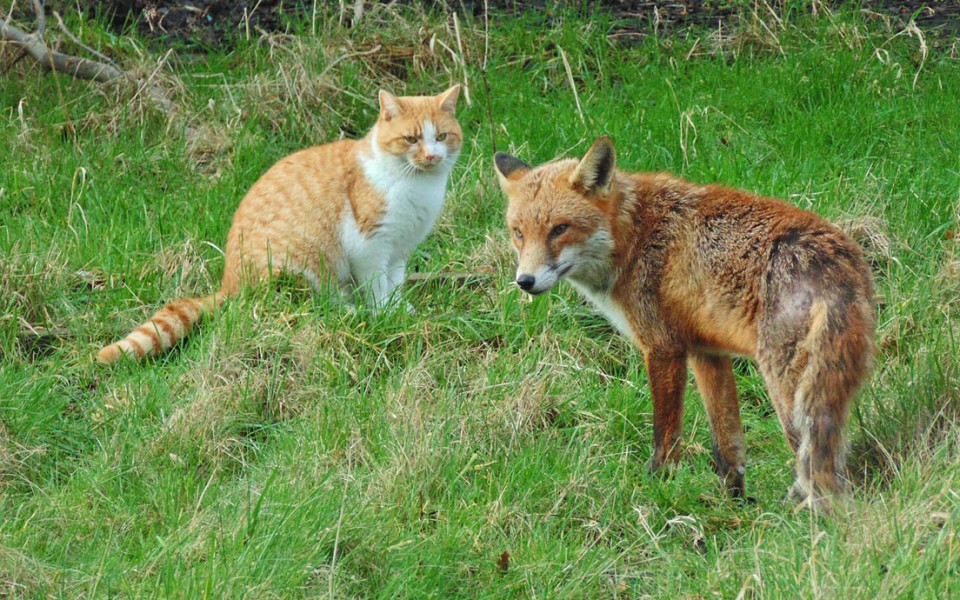
In the end, genes affect hormones that, in turn, influence growth rates and patterns. Hormone secretion can be affected by the animal’s nutrition, but there are physiological and behavioural factors that serve to limit the amount of food an animal can eat and thus affect growth. Access to above average food, in reduced competition environments (being an only child, for example) can lead to above average sizes. Is this happening to urban foxes in Britain, though?
They might be giants
One of the reasons foxes thrive in our towns and cities is thanks to human activity, our messy and wasteful tendencies in particular. Sadly, discarded fast food litters many town and city streets on a Friday and Saturday night and while, to us, the idea of eating rubbish is generally repulsive, it’s a valuable resource for a lot of urban wildlife. Moreover, this waste is so abundant that relatively little effort or risk is involved in getting it. A fox has a higher net gain of calories eating the remains of a fried chicken meal dumped in its territory than it does from searching for, sneaking up on, chasing and catching a rabbit. The result is that more resources can be devoted to growth and more fat gets laid down.
A study conducted in Sweden during the late 1970s by Erik Lindstrom found that, just like in humans, fat accumulation was related to the amount of food available to the fox and the amount of exercise the animal got. Lindstrom looked at the fat deposits in 463 Red fox vixens shot during the autumn and winter between 1975 and 1979; he found that the number of wild berries available determined how much fat was laid down in the autumn and the depth of snow determined how much fat was lost during the winter. Snow is difficult to walk through and doing so burns a lot of calories. Thus, in harsh winters with heavy snowfalls foxes lost more fat than when there was little or no snow on the ground. Obviously, there are other factors at play, such as food being more difficult to locate in heavy snow, but it illustrates something most of us are now all too familiar with: lots of food and little exercise can pile on the pounds.
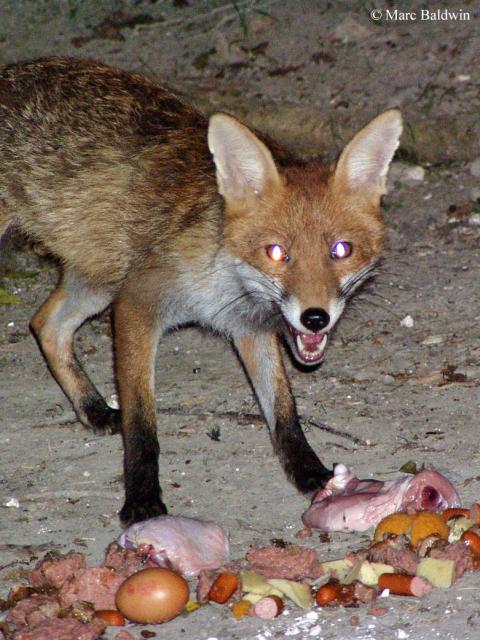
Scavenge isn’t the only food that foxes have access to in our parks and gardens: in many areas people actively feed their local wildlife. Indeed, the spreads I have seen some people lay out for foxes visiting their gardens (sausages, eggs, cheese, chicken, even chocolate gateaux and roast dinner carcasses) gave me the impression that some foxes eat better than I do. This supplemental feeding has three main impacts: it can increase the number of foxes in the area, which has consequences for disturbance; it might make the foxes less wary of humans, although this has not been my experience; and it can potentially lead to fatter foxes which get their entire nightly energy budget within only a couple of gardens, thereby getting less exercise. Moreover, some pet foods are very high in energy, so a small amount goes a long way, but are also less filling than, say, a mouse or a bird – foxes may be inclined to eat more of it.
While it is true that most people are sensible in the rations they put out, there can be a cumulative effect. The mammologists at Bristol University found that, when the city’s fox population was at its highest in the early 1990s, there was at least 150-times more food put out by residents in the north-west of the city than the foxes actually needed. The study, led by Professor Stephen Harris, uncovered a positive feedback loop: as the number of people putting out food increased, more fox sightings were reported and more food was put out, leading to each given patch being able to support more and more foxes.
Throughout their range, foxes exhibit considerable variation in body size and weight. Males are typically bigger than females and both sexes tend to be larger in the north of their range than the south, in accordance with Bergmann’s Rule. Studies in Scotland during the late 1960s and early 70s by the eminent naturalist Hugh Kolb found that foxes were smaller in the south of the country where population density was highest; more foxes equates to less food per head and correspondingly smaller animals. Similar data were presented by Paolo Cavallini in central Italy, which is home to the smallest European foxes, and Yoram Yom-Tov in Spain.
In Pisa, in the south of Cavallini’s study area, as in Scotland, foxes were smaller and their population larger than in the north of the country and one of his conclusions was that the “body size of the red fox may be variable even within a small area”. Cavallini considered that population density and phylogenetic distance (how closely-related the populations were) were the driving forces behind this variation in body size.
In a study published in 2007, Yom-Tov and his colleagues presented their analysis of 267 skulls held at the Natural History Museum in Madrid, which revealed that foxes from agricultural areas of Spain were significantly larger than those from non-agricultural areas. The authors suggested that increased food, largely because of more livestock in Spain, was the cause of the increased body size.
People power. Does human food change fox skulls?
In her 2008 children’s book Foxes, Sally Morgan wrote:
“Scientists have discovered that the urban fox is developing a different jaw to that of the rural fox as it scavenges for food rather than kills it.”
Having spoken with Sally about this, it appears to be a misinterpretation of work by scientists in Israel – more on that in a moment. Coincidentally, however, a new study looking at fox skulls collected in London during the 1970s does suggest a change in skull morphology associated with city living and a heavily anthropogenic diet.

In a 2003 paper to the journal Evolutionary Ecology Research, Yoram and Shlomith Yom-Tov at Tel Aviv University and Hans Baagøe at the University of Copenhagen presented their analysis of 272 fox and 308 badger skulls collected from Denmark between 1862 and 2000. The data show that, over the last 140 years, there has been an increase in three of the four skull characteristics they measured. These skull characteristics (zygomatic breadth, length of fourth upper premolar and canine diameter) are all associated with diet and body size and some had increased by as much as 10%, suggesting that Danish foxes are now larger than they were in the previous century and capable of handling larger prey.
The increase in zygomatic breadth, which allows for the attachment of a larger jaw-closing muscle, was much more noticeable in foxes from Zealand, where there are more large farms and estates with abundant gamebirds, hares and roe deer, than those of the Jutland Peninsula, suggesting that a better quality diet of larger prey may have driven the change. The authors also point to an increase in roadkill and improvement in living standards in Denmark, the latter resulting in an increase in garbage, as having provided easily available food for foxes.
So, these data imply that foxes in some areas have evolved larger skulls in response to the presence of human-mediated landscape changes; farmland management promoting roe deer colonisation and the introduction of species such as hares and gamebirds. Roe kids, pheasants and hares are larger than mice, voles and rabbits and larger jaws offer a distinct advantage when tackling such prey. Recent data from Britain, however, suggest that city living is having the opposite effect on foxes.
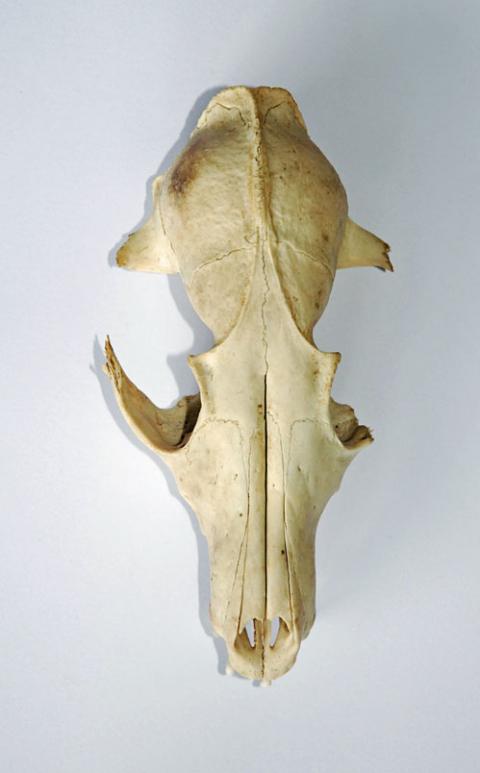
Kevin Parsons at the University of Glasgow and his colleagues studied the skulls of 111 red foxes (Vulpes vulpes) collected from London and surrounding boroughs in the early 1970s by Stephen Harris. The researchers grouped the skulls, now housed in the collections of the National Museums Scotland, into either urban or rural animals and took a total of 55 measurements from each. The team found, unsurprisingly, that sex had the largest influence skull size and shape, but, after controlling for that, habitat also had a significant impact. There was a clear difference between urban and rural individuals, with metropolitan skulls having a shorter and wider snout, with smaller jaws. The sagittal crest on the top of urban skulls was also longer, while the zygomatic arches and brain case were smaller.
Parsons and his co-workers suggest that urban food is more likely to be accessed in a stationary situation and may require more force to get into, accounting for the greater mechanical advantage provided by a shorter snout and potentially stronger bite, while a narrower snout with a faster jaw closing reflex is likely to be vital for rural animals when it comes to catching fast moving prey, such as mice and voles. Indeed, it may be that our towns and cities relax selection by providing more food and less need to hunt. Additionally, while an overall smaller brain case may indicate a smaller brain, something we see during the domestication process, the authors are quick to caution against jumping to conclusions – it could, they suggest, reflect changes in biomechanical forces operating on the skull.
Finally, these skull data suggest that vixens may be better adapted to city living than males, these skull differences being substantially greater in females than males. The theory goes that females, with dependent cubs to tend to for several months of the year, interact more closely with local food resources than males and, in their 2020 paper to the Proceedings of the Royal Society, Parsons and his colleagues explain:
“This may also confer greater cognitive demands in females explaining their relatively enlarged crania. In contrast, male red foxes engage in vigilant behaviours more frequently during periods of parental care and this may involve defensive actions that favour the faster more elongate jaws we observed.”
As an interesting side note, the findings of Parsons and his team mirror observations by Lyudmila Trut and colleagues in Russia, who found that selecting for docility (i.e. ‘friendliness’) in foxes resulted in an evolution towards smaller muzzles and jaws, although this was unrelated to diet. It should also be noted that change in skull dimensions does not necessarily correlate to a change, certainly a noticeable change, in body size.
The big picture in Britain
In 2010, I conducted a ‘vox pop’ of some pest control companies, asking if they kept records of the measurements of the foxes they were called out to remove; the answer was no. The suggestion that urban foxes are getting bigger is, it seems, more of a “general feeling” within the industry, rather than a statement based on any particular figures. Some of the controllers work closely with the Food and Environmental Research Agency (a branch of DEFRA), who collect the carcasses and examine them for any signs of parasitic Trichinella roundworms. FERA weigh each fox they collect before testing for the parasite, but they haven’t conducted any analyses on size, either across the country or over time, and thus could not comment on any trends.

With the pest controllers and FERA out of the picture for data, I contacted several rescue and research organisations to ask whether they’d noticed any trends in fox size. Nobody at Oxford University’s WildCRU unit is currently working on these animals, so they couldn’t help, but Bristol University’s Mammal Research Unit told me that they hadn’t seen an increase in body size during the 50 years of their on-going study. Similarly, the Fox Project, a charitable organisation who rescue and rehabilitate foxes from across the country, told me “average fox weights are the same as they’ve ever been”. The Project have handled more than 7,000 animals during their 20 years in operation and the bulk were around 4.5kg (10 lbs); only one animal was much heavier, at just under 10kg (22 lbs).
The picture was broadly the same at Vale Wildlife Rescue in Gloucestershire, who recently celebrated their 30 year anniversary; in that time, they have dealt with an average of two foxes per week, more than 3,000 animals in all, and haven’t noticed a significant change in the size of the urban foxes in that time, albeit they do often find urban ones are slightly heavier than their rural counterparts.
Foxes aren’t legally considered vermin, which means that local councils aren’t obliged to control them, but most councils are responsible for removing foxes found dead in their jurisdiction owing to the potential public health risk. Some councils have designated patrols that look for carcasses, while others rely on members of the public to report them. In May 2011, I contacted 55 local councils in England, Wales, Scotland and Ireland asking what happened to the carcasses they recovered and whether any information about them (length, weight, sex etc.) was recorded. The majority of the 30 councils that responded sent the carcasses for incineration, although a few (notably in Scotland) sent them to landfill and Dublin city council sent theirs for ‘deep burial’. In no case did councils collect any data on the animals they dealt with other than (in a few cases) the date and location. Ultimately, if there is evidence that larger than average foxes are being seen in urban areas more frequently, it appears to exist only with a select few pest controllers.

Red Fox (Spells Danger?)
So, if there are no data to support claims that urban foxes are getting bigger, how about “more deadly”?
Statements have been made in the press that people are now frequently bitten by foxes, but that most incidents go unreported. While it’s true that there’s no organisation responsible for maintaining records of animal bites, at the same time, unless incidents are reported with details it becomes impossible to draw conclusions. If people were bitten while trying to hand-feed or touch/handle a fox, for example, it is difficult to conclude that foxes are more dangerous than they were a decade ago.
There may be cases where feeding foxes makes them less wary of people, particularly when handfeeding is involved, but city-living in general seems to be a bigger factor in species becoming less reactive to our presence. Generations of animals grow up in the presence of humans that, by and large, present no threat and don’t really warrant running away from. Similarly, foxes are highly intelligent and behaviourally flexible, allowing them to rapidly adjust their flight distance according to an ever-changing threat analysis. Foxes also don’t appear to readily form assumptions about people, by which I mean any given fox will often be very relaxed with someone it knows and trusts, while maintaining a healthy distrust of strangers. Foxes are individuals; each sitting on that shy-boldness continuum (see Are foxes getting bolder and, if so, why?).

It is important to remember that, despite often confusing the two, boldness and aggression are different behavioural elements and not necessarily concomitant. A robin that takes mealworms from your hand or a cat that approaches you and rubs itself against your leg might be considered bold, but few would anticipate aggression, yet it in the eyes of some, a fox that fails to run when approached poses a threat. As Adele Brand and I put it in a recent paper to Mammal Communications:
“It is interesting to note that other urban mammals, such as red deer Cervus elaphus in Richmond Park, are not expected to be nocturnal, and yet a perception that foxes are “cheeky” or “brazen” if not strictly active by night persists.”
When it comes to foxes, perhaps preconceived notions from childhood stories and the media influence our opinions more than we recognise, overinflating the risk we ascribe to this mesocarnivore.
The aforementioned notwithstanding, I have seen photos of foxes lying on sofas, eating off kitchen floors and lying in front of the fire with pet dogs. I must concede that we cannot entirely dismiss the idea that if someone has encouraged a particular behaviour, such as approaching people or entering houses for food, some foxes may be more willing to capitalise on the experience and try approaching strangers. As I’ve already mentioned, though, this has never been my experience and I have no evidence that this is a common occurrence. I would, however, always urge people to err on the side of caution when interacting with wildlife. In the end, foxes are not extended pets: they’re wild predators and should be treated as such.
In terms of confirmed cases of foxes entering houses, there are conditions such as toxoplasmosis that can cause foxes to want to associate more with humans and there are more pet foxes in Britain than many assume, which sometimes escape. Additionally, well-grown cubs may be tempted to enter houses while exploring their parents’ territory. Typically, though, foxes are more targeted in their actions, which manifest from their experiences.

One fox I watched for several weeks a few years back sat in roughly the same spot on the lawn of a block of flats to await the food thrown out of one of the windows. These flats have two blocks with four areas of grass arranged around the outside. The fox trotted casually across each lawn, stopping periodically to scratch and sniff, but it only sat on this lawn, under this one window – it ignored the other seven windows bordering the lawn from which food could potentially come. This implied to me that the fox didn’t just see a lawn and a window and assume it was a good place to sit and wait for food – there were specific aspects of this particular lawn, this particular window and this particular time that prompted the fox to sit there and wait.
The long and the short of it …
In conclusion, an increase in the amount and/or quality of food can have an influence on the size to which an animal grows, particularly if this is provided during the crucial growth phase, although there are limits imposed by genes and the physics of large body sizes. Similarly, as the diet of the Red fox adapts in line with the changes we impose on the landscape, evolution in morphology is not unexpected, although there is only limited evidence to imply increased urban food availability may be driving an increase in body size.
To the exclusion of the FERA study, it appears that there are no data being routinely collected on fox size or weight in Britain and as such no evidence is available to verify the claim that urban foxes are growing larger, leaving us with only anecdotal evidence and the ‘gut feeling’ of some. Indeed, the data that are available from long-term studies, such as that conducted by the University of Bristol, and the experience of wildlife charities suggests that there is no apparent trend towards larger foxes.
Urban living makes most species bolder, but an increase in aggression is not the logical conclusion to this process. Foxes are wildlife, not pets, and we’re setting the bar too high if we expect them to instinctively conform to our expectations.